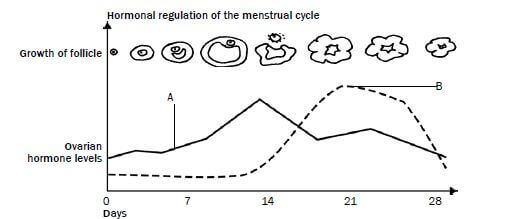ElimuZA Access to Education
REPRODUCTION - LIFE SCIENCES QUESTIONS AND ANSWERS
Share via Whatsapp Join our WhatsApp Group Join our Telegram GroupActivity 1
Questions
- Name the accessory glands of the male reproductive system and give ONE function of each. (10)
- Name the organ where testosterone is produced. (1)
- Give TWO functions of testosterone. (2)
- Name all the parts of the sperm cell that are responsible for movement. State what the function of each part is. (4)
- Explain the role of the nucleus of the sperm cell in fertilisation. (3) [20]
Answers to activity 1
- Seminal vesicle ✔ produces a fluid that contains nutrients ✔ for the sperm cells, so that they have energy to swim.✔
Prostate gland ✔ produces an alkaline fluid ✔ that neutralises acids ✔ produced in the vagina, so that sperm cells are protected.✔
Cowper’s gland✔ produces mucus✔ that helps with the movement✔of sperm cells. (10) - Testes✔ (1)
- Testosterone is responsible for the development of male secondary sexual characteristics✔ and it stimulates the maturation of sperm cells.✔ (2)
- Mitochondria✔ provide energy for swimming.✔ Tail✔ moves in a whip-like fashion to propel the sperm cell forwards.✔ (4)
- The nucleus contains 23 chromosomes (n)✔, and fuses with the nucleus of an egg cell, which also contains 23 chromosomes (n)✔. The result is a zygote with
46 chromosomes (2n).✔ (3) [20]
Activity 2
Questions
Provide the correct biological term for the following definitions.
- The inner lining of the uterus (1)
- Tube that connects the ovaries to the uterus (1)
- The structure that produces female hormones (1)
- The part where development of the embryo/foetus normally takes place in humans (1) [4]
Answers to activity 2
- Endometrium✔
- Fallopian tube✔
- Ovary/placenta✔
- Uterus✔ [4]
Activity 3
Study Figure 4.6 below and answer the questions that follow.
Figure 4.6 Hormonal changes during the menstrual cycle
- Name the hormones A and B. (2)
- Give reasons for your answers in question 1. (2)
- What event occurs on day 14? (1)
- Name the other two hormones involved in this cycle. (2)
- Did fertilisation occur during the cycle shown in Figure 4.6? (1)
- Explain your answer in question 5. (2) [10]
Answers to activity 3
- A - Oestrogen✔ B - Progesterone✔ (2)
- A: The Graafian follicle secretes oestrogen✔/Oestrogen reaches its maximum level before ovulation.✔
B: The corpus luteum produces progesterone✔/Progesterone reaches its maximum level after ovulation.✔ (2) - Ovulation✔ (1)
- LH✔ and FSH✔ (2)
- No✔ (1)
- Progesterone levels decrease✔ towards the end of the cycle.
The corpus luteum decreases✔ in size. (2) [10]
HINT:
Here is a hint to help you to remember the names of the two hormones:
- O stands for Oestrogen and when it is high, Ovulation occurs.
- P stands for Progesterone and when it remains high, there is a Pregnancy.
Activity 4
Questions
- On which day of the menstrual cycle does ovulation usually take place? (1)
- What happens to the Graafian follicle after ovulation? (1)
- Name the TWO hormones that are released by structures in the ovaries. (2)
- Give THREE functions of the amniotic fluid. (3)
- Give TWO substances that can move from the mother to the foetus through the placenta. (2)
- Give TWO substances that can move from the foetus to the mother through the placenta.
Answers to activity 4
- Day 14✔ (1)
- It changes into a corpus luteum.✔ (1)
- Oestrogen✔ and progesterone.✔ (2)
- The amniotic fluid protects the foetus against shock✔, drying out✔ and temperature changes.✔ (3)
- Oxygen✔, nutrients✔ (amino acids, glucose, other sugars), viruses✔ and drugs✔ (2)
- Carbon dioxide✔ and waste products✔ (urea). (2) [11]
Published in Life Sciences Grade 12 Study Guide and Notes